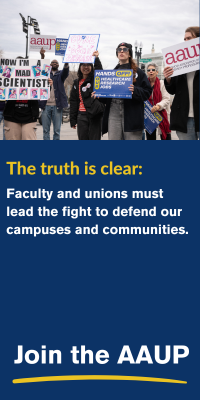- About
- Programs
- Issues
- Academic Freedom
- Political Attacks on Higher Education
- Resources on Collective Bargaining
- Shared Governance
- Campus Protests
- Faculty Compensation
- Racial Justice
- Diversity in Higher Ed
- Financial Crisis
- Privatization and OPMs
- Contingent Faculty Positions
- Tenure
- Workplace Issues
- Gender and Sexuality in Higher Ed
- Targeted Harassment
- Intellectual Property & Copyright
- Civility
- The Family and Medical Leave Act
- Pregnancy in the Academy
- Publications
- Data
- News
- Membership
- Chapters
A Tip Of The Hat
Higher Education And The American Dream: Success And Its Discontents. Marvin Lazerson. Budapest: Central European University Press, 2010.
Currently a professor of higher education in the Department of Public Policy at Central European University and professor emeritus at the University of Pennsylvania, Marvin Lazerson has served on the faculties of Harvard University, Stanford University, and the University of British Columbia. While at the University of Pennsylvania, he entered academic administration, serving as dean of the Graduate School of Education and as the university’s interim provost before returning to the faculty. I had the privilege of learning from Lazerson while in graduate school at Penn.
Higher Education and the American Dream: Success and Its Discontents borrows from Lazerson’s knowledge of the literature on higher education and his considerable experience as a professor and administrator. The book often reads like a memoir, as Lazerson shares personal experiences from his childhood, his career as a professor, and, above all, his more recent work as a dean and interim provost at an Ivy League school to explain the governance structure and typical interactions among faculty members, trustees, administrators, and students.
The book is organized into four sections: (1) “The Gospel of Getting Around,” (2) “Governance and Managerial Dilemmas,” (3) “The Teaching and Learning Conundrum,” and (4) “Making Things Better.” Of particular interest for members of the AAUP is chapter 3, “Who Governs Higher Education?” In it, Lazerson chronicles the decline of professors’ control of the academic enterprise as the proliferation of institutional managers and activist trustees from the business sector has become commonplace. Lazerson, writing about both academic decision making and other institutional planning during his time as an administrator at Penn, says that “although individual professors were sometimes participants in these decisions, faculty as a constituency was rarely consulted and if they were, the consultations were perfunctory, a pro forma tipping of the hat to older practices or codified rules that said the faculty must be consulted.” This lack of shared governance extended to other constituencies. Lazerson writes that as interim provost he was once “delegated to ‘handle’ the students” when decisions were made to suspend discussions about a new student center.
While many of us have experienced what seems like the “pro forma tipping of the hat,” the trend among administrators of asking for faculty suggestions even though a decision has already been made is worrisome. Nonetheless, the principles of shared governance allow colleges and universities to continue to maintain their unique status as institutions where the pursuit of knowledge and the creation of active and engaged citizens are not overshadowed entirely by the financial managers’ and trustees’ pursuit of the best “return on investment.”
One of the downsides of academic memoirs is that they draw only upon the author’s experiences and often lack extensive citation. For example, in Higher Education and the American Dream, Lazerson focuses his attention on the elite universities with which he is most familiar. While the elite universities certainly contribute to the “American dream” of some, National Center for Education Statistics data that track attendance of Pell Grant recipients show that they continue to serve primarily those students who enter higher education with privilege. Not considering the regional and state colleges and universities and minority-serving institutions that enroll most of the first-generation, African American, Latino, and American Indian students in the United States who are still striving for the “American dream” weakens Lazerson’s arguments. (The chapters reflecting upon vocational education and reform do mention the work of community colleges within America’s postsecondary education system, although none is mentioned by name.)
Not once in the book are historically black colleges and universities, Hispanic-serving institutions, tribal colleges and universities, or Asian American and Native Pacific Islander–serving institutions even mentioned. For example, even when discussing the second Morrill Act of 1890, which gave federal funding to the states to support black colleges and universities, Lazerson does not distinguish the federal support provided by the act from the original creation of land-grant colleges and universities in 1862. Minority-serving institutions continually outperform historically white institutions when it comes to graduating students who are typically underrepresented in higher education in the United States. For example, according to the 2010 US Commission on Civil Rights report The Educational Effectiveness of Historically Black Colleges and Universities, although historically black colleges and universities account for only 3 percent of all postsecondary institutions, 40 percent of all African Americans with bachelor’s degrees in the physical sciences and 38 percent of those with degrees in math or biological sciences graduated from a historically black college or university.
Despite my concerns about this book, it was a pleasure to read. The unique perspective of this long-term administrator and education historian made Lazerson’s memoir particularly compelling. Lazerson acknowledges many of the challenges facing American higher education, especially in the current economic downturn. Perhaps with hard work, including strong systems of truly shared governance, more and more Americans will be able to partake in the American dream Lazerson professes.
Noah D. Drezner is assistant professor of higher education at the University of Maryland College Park. His research focuses on philanthropy and fundraising in higher education as well as the contributions of minority-serving institutions. His e-mail address is [email protected].




